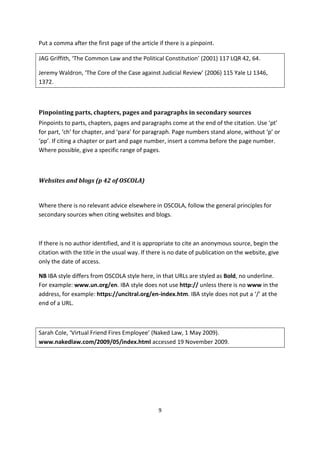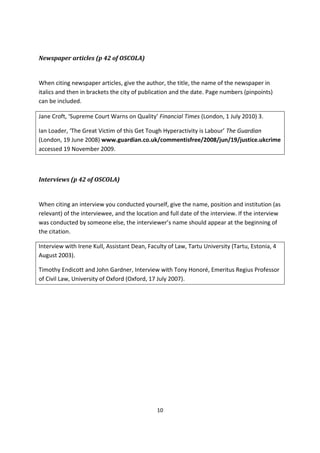This document provides guidance on footnote referencing styles based on the Oxford Standard for Citation of Legal Authorities (OSCOLA). It discusses how to format footnotes for different types of legal sources, including cases, legislation, books, journal articles, websites, newspaper articles, and interviews. Footnotes should include author names, titles, publication details, and pinpoint references in a clear and consistent manner according to OSCOLA standards.
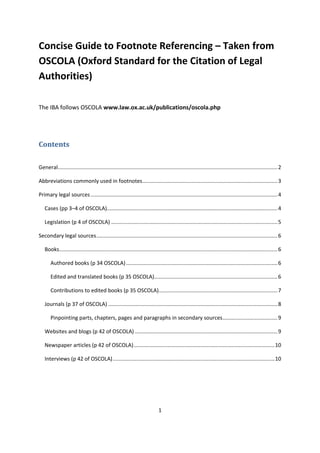
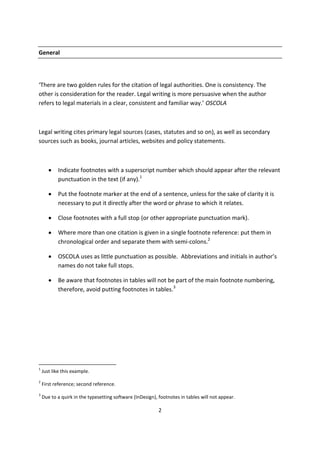
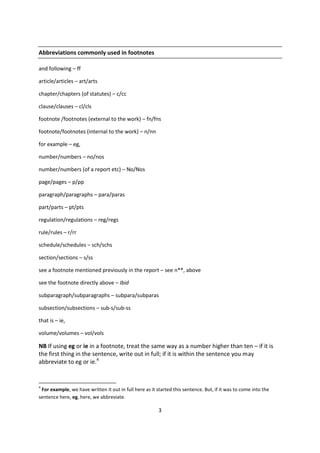
![4
Primary legal sources
Cases (pp 3–4 of OSCOLA)
When citing cases in footnotes, give the name of the case; the neutral citation (if
appropriate); volume number and first page of the relevant law report; and, where
necessary, the court. If the name of the case is given in the main text, it is not necessary to
repeat it in the footnote.
It is well represented in the case law, perhaps most notably in the expression of
the no-conflict rule advocated by Lord Upjohn in Phipps v Boardman,31
and in the
earlier Court of Appeal decision in Boulting v Association of Cinematograph,
Television and Allied Technicians.32
In Boulting [or ‘in the Boulting case’], Upjohn LJ
said that the rule ‘must be applied realistically to a state of affairs which discloses
a real conflict of duty and interest and not to some theoretical or rhetorical
conflict’.33
In Phipps, Lord Upjohn developed his view of the rule further by adding
that there must be a ‘real sensible possibility of conflict’.34
The relevant footnotes would appear as follows:
31
[1967] 2 AC 46 (HL).
32
[1963] 2 QB 606 (CA).
33
Boulting (n 32) 638. OR 33
Ibid 638.
34
Phipps (n 31) 124.
The numbers at the end of footnotes 33 and 34 are called ‘pinpoints’; they give the page on
which the quotation can be found. It is also acceptable to include the full case reference in
all footnotes.](https://image.slidesharecdn.com/4-180226152431/85/4-concise-guide-to-footnotes-1-4-320.jpg)

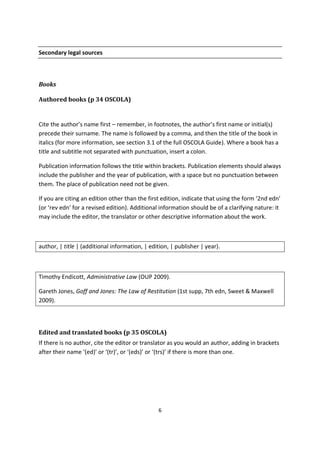

![8
Journals (p 37 of OSCOLA)
When citing articles, give the author’s name first, followed by a comma. In footnotes, the
author’s first name or initial(s) precede their surname.
Then give the title of the article, in Roman within single quotation marks. After the title, give
the publication information in the following order:
year of publication, in square brackets if it identifies the volume, in round brackets if
there is a separate volume number;
the volume number if there is one (include an issue number only if the page
numbers begin again for each issue within a volume, in which case put the issue
number in brackets immediately after the volume number);
the name of the journal in roman, in full or abbreviated form, with no full stops; and
the first page of the article.
author, | ‘title’ | [year] | ‘journal name or abbreviation’ | first page of article.
[OR]
author, | ‘title’ | (year) | volume | ‘journal name or abbreviation’ | first page of article.
For guidance on journal abbreviations, see section 4.2.1 of the appendix in the main
OSCOLA Guide. Abbreviations do vary, so choose an abbreviation and stick with it
throughout your work. [Alternatively, www.legalabbrevs.cardiff.ac.uk can be helpful – but
remember to remove full stops in abbreviations.]
Some publishers prefer all journal names to be given in full.
Paul Craig, ‘Theory, “Pure Theory” and Values in Public Law’ [2005] PL 440.
Alison L Young, ‘In Defence of Due Deference’ (2009) 72 MLR 554.](https://image.slidesharecdn.com/4-180226152431/85/4-concise-guide-to-footnotes-1-8-320.jpg)
